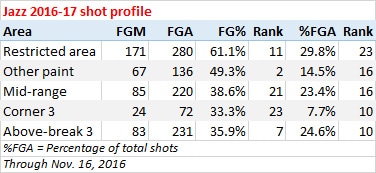
The Utah Jazz were a team many thought would be “Most Improved” this season. Many thought the same thing last season, actually.
This season, though, there were clearer signs that the Jazz would make a jump. While they were 40-42 last season, they had the point differential of a 47-win team and were plagued by late-game failures. And in the summer, they added depth and made a huge upgrade at point guard, acquiring George Hill in a three-team trade.
Early season injuries to Hill, Gordon Hayward and Boris Diaw have slowed their progress, but the Jazz are still 7-5 through 12 games, with seven of the 12 having been played against teams currently over .500.
The Basics – Utah Jazz
Pace: 93.0 (30th)
OffRtg: 105.3 (13th)
DefRtg: 100.5 (7th)
NetRtg: +4.7 (9th)
Jazz links: Team stats | Player stats | Player shooting | Lineups
The Jazz have also won five of their last six games on the road. But they’re at home on Thursday, hosting the Chicago Bulls in the second game of TNT’s double-header (10:30 p.m. ET).
No. 1
According to SportVU, the Jazz have allowed their opponents to take only 11.4 percent of their shots in the first six seconds of the shot clock, the second lowest rate in the league.
Good defense starts in transition. League-wide, field goal percentage (and effective field goal percentage) is highest in the first six seconds of the shot clock. If you prevent early shots, you increase your chances of getting a stop.
Rudy Gobert’s rim protection is critical to the Jazz’s defensive success. But their ability to get back in transition and prevent early offense allows Gobert to be in position to protect the rim more often. Through Wednesday, Gobert ranks fifth in rim protection (with opponents shooting just 39.3 percent at the rim when he’s there), and third with 9.3 shots defended at the rim per game. The quantity is just as important as the quality.
Last season, Jazz opponents got 13.0 percent of their shots in the first six seconds of the shot clock, the 12th lowest rate in the league. The improvement has come with a sacrifice: Utah has grabbed only 19.6 percent of available offensive boards (25th in the league) this season, down from 25.9 percent (fourth) last season.
Clearly, Jazz coach Quin Snyder has prioritized transition defense over offensive boards.
No. 2
The Jazz are the only team with two players in the top 10 in effective field goal percentage from outside the paint.

Utah is the eighth most improved offensive team in the league, having scored 2.1 points per 100 possessions more than it did last season. That’s not a huge jump, but when you have a top-10 defense, going from a below-average offense to an above-average offense is a key step toward contending for a top seed in your conference.
The Jazz have made that step despite the huge drop-off in offensive rebounding percentage noted above. They’ve had the league’s second biggest decrease in turnover rate (from 15.8 to 13.4 per 100 possessions), and they’ve shot better.

As a team, the improved shooting has come inside the paint, where they’ve shot 57 percent (up from 53 percent last season). But Hill and, especially, Rodney Hood, have kept them afloat from the perimeter.
Hill has missed the last five games, but Hood has remained hot from the outside. His 60 percent from mid-range is unsustainable, but Utah should get better shooting from Hayward and others as the season goes on.

No. 3
The Jazz have outscored their opponents by 34 points in 87 minutes with Joe Johnson at the four.
The Jazz haven’t had much lineup continuity this season. Their most-used lineup includes Diaw (who missed eight games) and has played just 44 minutes together, fewer than the most-used lineup of 26 other teams. Only Brooklyn, Denver and Memphis don’t have a lineup that has played more.
But within Utah’s assortment of 132 not-so-heavily-used lineups, there’s some interesting data regarding new addition Johnson. And that’s how good the Jazz have been playing small.
Derrick Favors and Gobert have been the anchors of Utah’s top-10 defense. The team has allowed less than a point per possession with the two bigs on the floor together over the last few seasons. But the additions of Johnson and Diaw give Snyder versatility at the forward positions, an ability to put more skill on the floor and keep it spaced.
That gives the Jazz a higher ceiling offensively. And it’s the offensive numbers that stand out with Johnson at the four. The Jazz have scored 120 points per 100 possessions in those 87 minutes. They’ve also allowed only 98 points per 100 possessions in those minutes, only 85 in the 55 minutes that Johnson has played the four with Gobert at the five.

The Jazz used a closing lineup of Hill, Hood, Hayward, Johnson and Gobert in their Nov. 6 win in New York. It outscored the Knicks 26-12 in just 10 minutes in that game, but with Hill having missed every game since, Snyder hasn’t been able to use it again.
Pace = Possessions per 48 minutes
OffRtg = Points scored per 100 possessions
DefRtg = Points allowed per 100 possessions
NetRtg = Point differential per 100 possessions
John Schuhmann is a staff writer for NBA.com. You can e-mail him here, find his archive here and follow him on Twitter.
The views on this page do not necessarily reflect the views of the NBA, its clubs or Turner Broadcasting.







